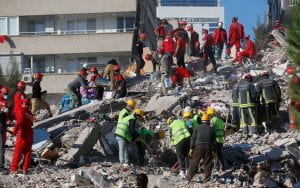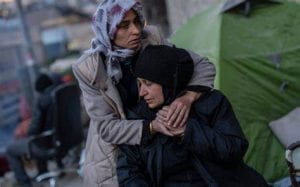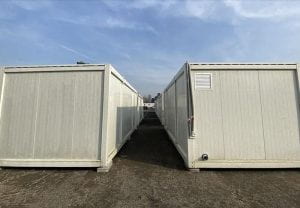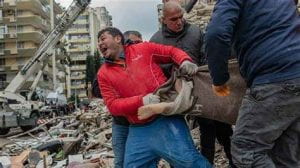This post is an update on the previous blog titled: The Natural-Humanitarian Disaster of the Turkey-Syria Earthquake. While this topic is no longer in our regular newsfeed, the consequences of disaster are very much ongoing. People n Turkey and Syria are still recovering from the devastating aftermath of the first earthquake that occurred on February 6th people and have yet to find a sense of calm. Trying to find a sense of normalcy, children have begun attending school, and parents have attempted to return to their usual lives. But there is still so much destruction, making it hard to do so. According to the latest records, the earthquakes have killed over 50,000 individuals and injured over 100,000. 214,000 homes have collapsed, leaving thousands in need of aid and shelter. There are still victims that have yet to be found or identified under the rubble of what was once their home. UNICEF has reported that earthquakes have impacted almost 5 million children. Even though the initial earthquakes have finished, the need for humanitarian assistance has worsened.
An Update
These earthquakes are incredibly destructive considering the conditions of the areas, mainly referring to Syria. Syria has already been going through one of the most significant humanitarian crises in the world. The earthquake has only worsened its conditions, and access to aid is even more limited. Access to aid has been a very important topic considering the governmental sanctions imposed by many of the big nations (USA, Europe, etc.), and part of the country is controlled by its own government. Other areas are under the control of NGOs. On February 12, Martin Griffiths, Under-Secretary-General for Humanitarian Affairs and Emergency Relief Coordinator at the UN, stated: “We have so far failed the people in north-west Syria. They rightly feel abandoned. Looking for international help that hasn’t arrived.” Over 4.1 million individuals in Syria depend on aid and assistance from NGOs, primarily women and children. Getting aid to Syria has been and is more difficult than getting aid in Turkey. It is especially apparent when comparing the aid given to both countries on an international level because, on the one hand, Turkey receives both international aid and support from its government. Yet, on the other hand, Syria, which is not controlled by one body of government, can receive partial international aid.

Problems in Syria
On February 14th, eight days after the initial earthquakes, border crossing points were finally opened for UN aid to be delivered to Syria. By February 22nd, 282 aid trucks were sent by 6 UN agencies. On February 19, Medical Charity Médecins Sans Frontiers (MSF), was able to send 14 aid trucks to Syria in an effort to assist with the rescue operations. As essential as these efforts of sending aid and providing help have been, many problems remain, mainly the governmental sanctions and the closed borders surrounding the affected areas. In addition, Syria is still undergoing a Civil war, making it even more challenging to receive the help they need. Since the initial earthquake, it took days for aid and rescue crews to arrive, which has critically impacted injured civilians and individuals stuck under the rubble of buildings. The Syrian regime has bombed the affected areas of Syria (Northwest area) over 84 times. Such attacks have caused damage to the border crossings, so many NGOs have requested for more crossing points to be available, especially considering the scarcity of resources in Syria and the inability of UN aid to reach the areas affected.

Efforts to help:
As seen, there is a lot of sadness surrounding the earthquakes and their aftermath. Along with the destruction, there have also been many organizations, individuals, and countries who have come to help, providing a sense of hope and relief. A group of online internet activists has created a website called TakeShelter, which enables displaced individuals to connect with hosts worldwide. This initiative was created and developed just 48 hours after the earthquakes occurred. One of the founders, Avi Schiffmann, stated that this website has reverted “power back into the hands of those displaced by the earthquake, allowing them to find shelter.” This website was launched through an organization called InternetActivism. This has opened many doors for activism and providing humanitarian care for generations to come. With almost everything being online, this website has paved the way for providing humanitarian support through a digital platform and helped over 100 families to find shelter in the homes of others.
Moreover, many countries have taken a stronger initiative by investigating earthquake destruction prevention methods. Iraq has begun to install 16 earthquake warning stations throughout the country. Iraq experienced some aftershocks from the initial earthquakes. Since then, they have worked to put different stations to monitor the earthquakes and future ones on the borders connected to Syria and Turkey. In addition, Saudi Arabia has built around 3,000 temporary homes to be sent to the victims in Turkey and Syria. Public, influential figures such as Cristiano Ronaldo have sent aid to those affected. There have been many reasonable efforts that have been made and shown.

What can you do?
In times like these, after the shock has been visible through news cycles, articles, and social media posts, people tend to think that this disaster is fixed, but that is not the case. The weeks after an initial humanitarian disaster can be much worse than the first day of it. As time passes, more family members are identified as dead or remain missing. Incomes for families have entirely disappeared, and now humanitarian aid support is required to survive. Those who have lost their homes are now living in community shelters or on the streets, and the conditions of those affected will continue to worsen unless we do something about such a situation. Hundreds and thousands of homes, schools and businesses must be rebuilt. The importance of donations, providing awareness and finding ways to help continues. Even though the earthquakes have stopped, millions continue to be displaced. Below are resources to donate and learn more about the cause.

“How to Help Victims of the Earthquake” New York Times Article by Ben Shpigel: This article showcases which donation links to use; check out Charity Navigator and GuideStar to ensure that the non-profits you donate to are reliable.
There are countless humanitarian groups accepting donations for those affected by the earthquake. For more resources, check out the links below:

